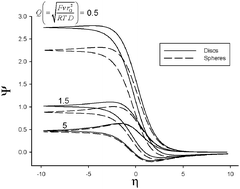Catalytic mechanism in cyclic voltammetry at disc electrodes: an analytical solution
Abstract
The theory of

* Corresponding authors
a
Departamento de Química Física, Universidad de Murcia, Espinardo 30100, Murcia, Spain
E-mail:
amolina@um.es
Fax: +34 868 88 4148
Tel: +34 868 88 7524
b
Department of Chemistry, Physical and Theoretical Chemistry Laboratory, Oxford University, South Parks Road, Oxford, UK
E-mail:
richard.compton@chem.ox.ac.uk
Fax: +44 (0)1865 275410
Tel: +44 (0)1865 275413
The theory of

 Please wait while we load your content...
Something went wrong. Try again?
Please wait while we load your content...
Something went wrong. Try again?
A. Molina, J. González, E. Laborda, Y. Wang and R. G. Compton, Phys. Chem. Chem. Phys., 2011, 13, 14694 DOI: 10.1039/C1CP21181A
To request permission to reproduce material from this article, please go to the Copyright Clearance Center request page.
If you are an author contributing to an RSC publication, you do not need to request permission provided correct acknowledgement is given.
If you are the author of this article, you do not need to request permission to reproduce figures and diagrams provided correct acknowledgement is given. If you want to reproduce the whole article in a third-party publication (excluding your thesis/dissertation for which permission is not required) please go to the Copyright Clearance Center request page.
Read more about how to correctly acknowledge RSC content.
 Fetching data from CrossRef.
Fetching data from CrossRef.
This may take some time to load.
Loading related content
